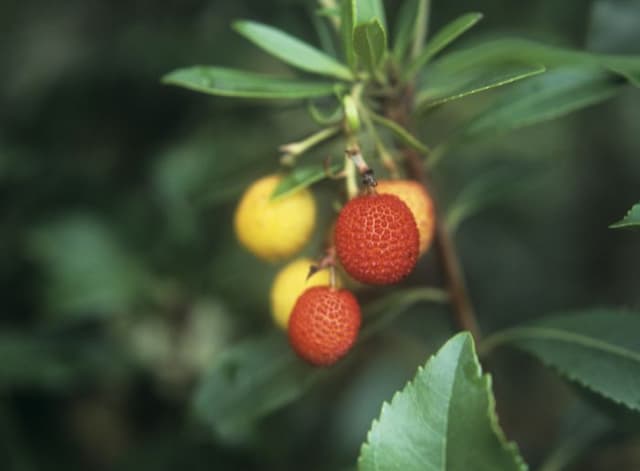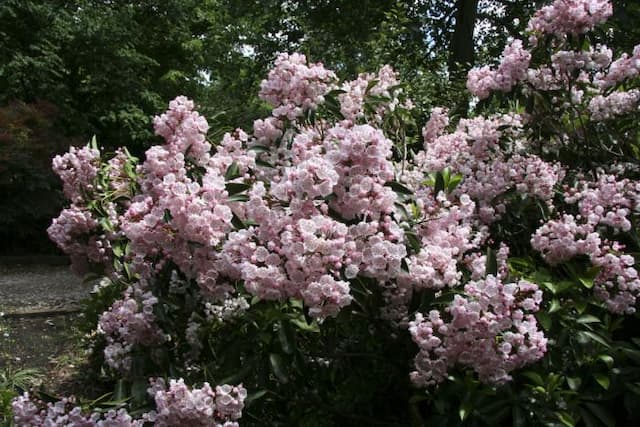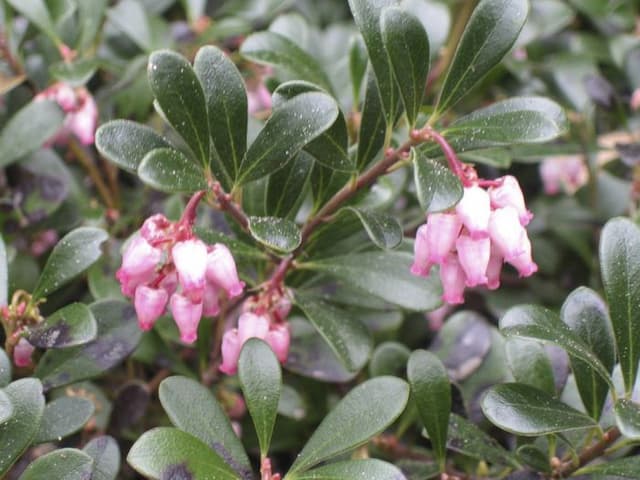Rhododendron Rhododendron 'Olivia'

ABOUT
The Rhododendron 'Olivia' is a captivating plant with a lush, rounded habit that draws attention with its vibrant and showy blossoms. The leaves are thick, glossy, and dark green, creating a perfect backdrop for the flowers. It blooms generously with clusters of delightful, trumpet-shaped flowers that radiate in shades of pink, often with a deeper blush at the edges and a paler center, occasionally featuring speckles or a throat of contrasting color. These blossoms emerge from buds that are equally ornamental, typically in a hue that may be deeper or more intense than the open flower. Positioned above the foliage, the flower clusters make a stunning display that attracts pollinators such as bees and butterflies. The overall appearance of Rhododendron 'Olivia' is one of classic beauty, contributing a burst of color and elegance to any garden setting where it's grown.
About this plant
 Names
NamesFamily
Ericaceae
Synonyms
Olivia Rhododendron, Olivia Azalea
Common names
Rhododendron 'Olivia'
 Toxicity
ToxicityTo humans
Rhododendron, including the 'Olivia' variety, is toxic to humans. It contains toxic compounds called grayanotoxins. If ingested, even in small amounts, it can cause symptoms such as nausea, vomiting, drooling, diarrhea, weakness, and loss of appetite. Severe poisoning can lead to more serious symptoms like abnormal heart rate, hypotension or hypertension, coma, and in extreme cases, death. It is crucial to avoid ingesting any part of the rhododendron plant.
To pets
Rhododendron is also poisonous to pets. The 'Olivia' variety, like all rhododendrons, contains grayanotoxins which can cause severe symptoms if ingested by animals such as dogs, cats, and horses. Symptoms of rhododendron poisoning in pets include vomiting, diarrhea, drooling, weakness, loss of coordination, and seizures. In severe cases, ingestion can lead to coma and potentially be fatal. Therefore, it is important for pet owners to prevent animals from consuming any parts of the rhododendron plant.
 Characteristics
CharacteristicsLife cycle
Perennials
Foliage type
Evergreen
Color of leaves
Green
Flower color
Pink
Height
4-5 feet (1.2-1.5 meters)
Spread
4-6 feet (1.2-1.8 meters)
Plant type
Shrub
Hardiness zones
5
Native area
Asia
Benefits
 General Benefits
General Benefits- Aesthetic Appeal: Rhododendron 'Olivia' is known for its beautiful flowers which can add vibrant colors and visual interest to gardens and landscapes.
- Habitat Support: Provides food and shelter for pollinators such as bees and butterflies, as well as birds, which may feed on the insects it attracts or its nectar.
- Versatility in Landscaping: Can be used in a variety of landscaping designs, including as a focal point, in borders, or as part of a larger shrubbery display.
- Seasonal Interest: Offers year-round interest with evergreen foliage, and seasonal flowers that bloom in the spring or early summer.
- Erosion Control: The dense root system can help stabilize soil and prevent erosion on slopes.
- Privacy: When planted in a group or as a hedge, Rhododendron 'Olivia' can act as a natural privacy screen due to its size and foliage density.
 Medical Properties
Medical PropertiesThis plant is not used for medical purposes.
 Air-purifying Qualities
Air-purifying QualitiesThis plant is not specifically known for air purifying qualities.
 Other Uses
Other Uses- Artistic inspiration: The striking blooms of the Rhododendron can be a muse for artists and photographers, providing a vibrant subject for their creative works.
- Natural dye: The flowers and leaves of Rhododendron may be used to produce natural dyes for fabrics or paper, giving a range of colors depending on the mordant used.
- Educational tool: Botany students and educators can use the Rhododendron 'Olivia' to study plant biology and hybridization techniques.
- Culinary decoration: Edible varieties of Rhododendron can have their flowers used to decorate cakes and pastries, adding an ornate touch to desserts.
- Fragrance extraction: Although not common, the scent from the flowers can be used to create light, floral fragrances in homemade perfumes or potpourris.
- Theme gardens: Rhododendrons can be the focal plant in theme gardens, such as an "all-pink" garden or an "acid-loving plants" garden.
- Photography workshops: Their vibrant colors and large blooms make Rhododendrons excellent subjects for photography workshops, especially in spring.
- Cultural ceremonies: In some cultures, Rhododendron flowers can be used during specific ceremonies or festivals as decorations or offerings.
- Soil erosion control: When planted en masse on slopes, Rhododendron 'Olivia' can help in controlling soil erosion due to its extensive root system.
- Wildlife habitat: Rhododendrons provide shelter and nesting sites for various species of birds and insects, playing a role in supporting local biodiversity.
Interesting Facts
 Feng Shui
Feng ShuiThe Rhododendron is not used in Feng Shui practice.
 Zodiac Sign Compitability
Zodiac Sign CompitabilityThe Rhododendron is not used in astrology practice.
 Plant Symbolism
Plant Symbolism- Caution: Rhododendrons, in general, can symbolize caution because some species contain toxic substances which can be harmful if ingested.
- Beware: Similarly, the warning of danger due to their toxic nature can also represent the need for awareness and scrutiny.
- Abundance: With their lush, full blooms and voluminous clusters, rhododendrons can represent abundance or wealth.
- Elegance: The Rhododendron's impressive appearance and vibrant colors can embody elegance and a sophisticated aesthetic.
- Homecoming: In some regions, the Rhododendron's blooming is a sign of spring and can be associated with homecoming or a return to one's place of origin.
 Water
WaterRhododendrons, including 'Olivia', require consistent moisture but do not tolerate standing water. Water the plant thoroughly when the top inch of soil feels dry to the touch, which typically means watering once a week during the growing season, depending on weather conditions. During the hot summer months, 'Olivia' may need more frequent watering, possibly twice per week. In cooler weather or rainy periods, reduce the frequency. Each watering should provide enough water to soak the root zone, which could mean using 1 to 2 gallons for a small to medium-sized plant. It's crucial to water the plant slowly to ensure deep soil penetration and prevent runoff.
 Light
LightRhododendron 'Olivia' thrives in dappled sunlight or partial shade. The best spot for this plant is one where it is protected from the harsh afternoon sun, which can scorch its leaves. Ideally, plant 'Olivia' where it can receive morning sunlight and afternoon shade or beneath a canopy of light trees or shrubs that filter the light.
 Temperature
TemperatureRhododendrons like 'Olivia' perform best in temperate climates with mild temperatures. They can typically tolerate minimum temperatures down to 20°F and maximum temperatures that do not often exceed 80°F. The ideal temperature range for 'Olivia' is between 50°F and 70°F. These plants are sensitive to extreme temperature changes, particularly during the winter freeze-thaw cycles.
 Pruning
PruningPruning a Rhododendron 'Olivia' is generally done to shape the plant, remove dead or diseased wood, and encourage bushier growth. The best time for pruning is immediately after the flowers have faded in late spring or early summer. This timing allows the plant to set buds for the next year's blooms. Prune selectively, cutting just above the growth nodes, and avoid heavy pruning as it can reduce flowering.
 Cleaning
CleaningAs needed
 Soil
SoilRhododendron 'Olivia', commonly known as the Rhododendron, prefers well-draining, humus-rich acidic soil with a pH range between 4.5 and 5.5. A good soil mix can be created using 50% pine bark, 30% perlite, and 20% peat moss to ensure proper drainage and acidity.
 Repotting
RepottingRhododendrons, like Rhododendron 'Olivia', generally require repotting every 2 to 3 years to prevent root-bound conditions and refresh the soil, but mature plants can be repotted less frequently, about every 3 to 5 years.
 Humidity & Misting
Humidity & MistingRhododendron 'Olivia' thrives best in moderate to high humidity levels, ideally between 50% to 60%. These plants can tolerate lower humidity, but the higher levels help support lush foliage and vibrant blooms.
 Suitable locations
Suitable locationsIndoor
Place in bright, indirect light and ensure high humidity.
Outdoor
Plant in partial shade, shield from strong winds, mulch well.
Hardiness zone
5-8 USDA
 Life cycle
Life cycleRhododendron 'Olivia', commonly known as Olivia Rhododendron, begins its life when a seed germinates in well-drained, acidic soil, ideally in partial shade. Following germination, the seedling goes through a juvenile phase, growing leaves and developing a root system. As it matures, the plant enters the vegetative stage, characterized by the growth of evergreen foliage and woody stems; during this time, it may be pruned to maintain a desirable shape and promote bushier growth. The reproductive stage follows, with the Olivia Rhododendron producing showy flowers typically in the spring, attracting pollinators necessary for seed production. After pollination and fertilization, seed capsules develop and mature, eventually releasing seeds to start the next generation. The plant will continue to grow and repeat the flowering and seeding cycle annually, with proper care, for many years, potentially decades.
 Propogation
PropogationPropogation time
Spring-Early Summer
Rhododendron 'Olivia', commonly known as Rhododendron, is best propagated by semi-hardwood cuttings. This method involves taking cuttings from the current year's growth when the wood has hardened slightly but is not yet mature, typically in late summer. Cuttings should be about 4 to 6 inches (10 to 15 centimeters) long and include several sets of leaves. The lower sets of leaves are removed, and the base of the cutting is dipped in rooting hormone to encourage root development. The prepared cuttings are then inserted into a pot filled with a mix of peat and perlite or sand to provide good drainage and aeration. The pot should be kept in a humid environment with indirect light and a consistent temperature to encourage rooting, which can take several weeks to a few months.









